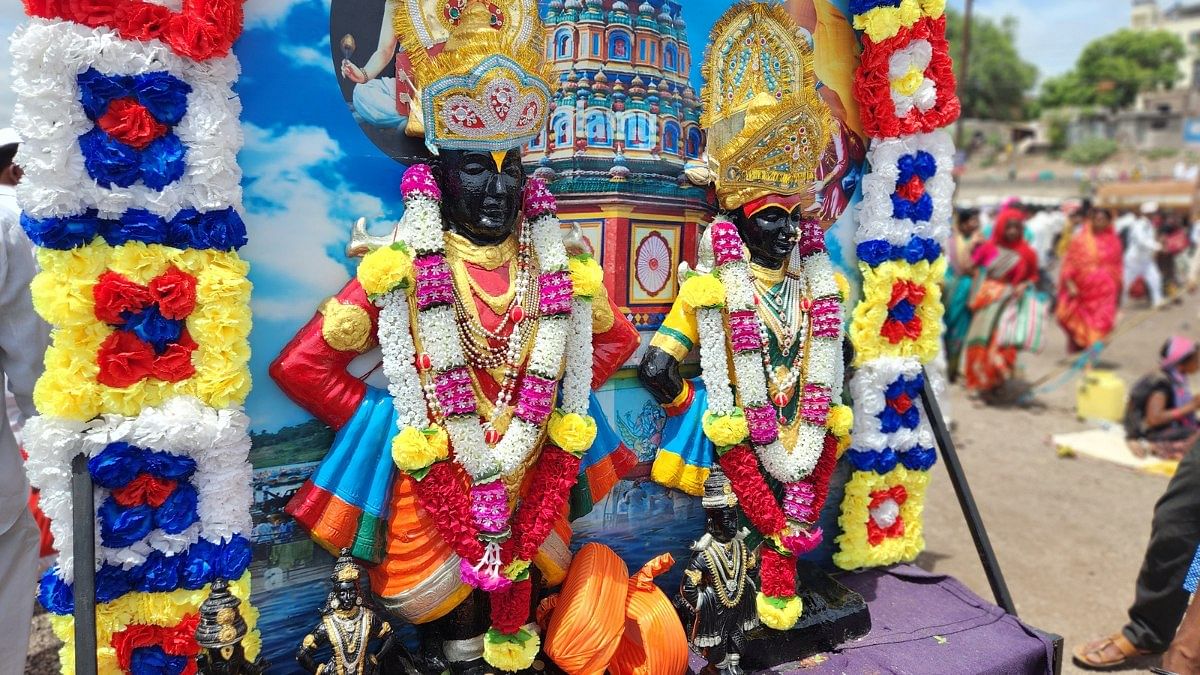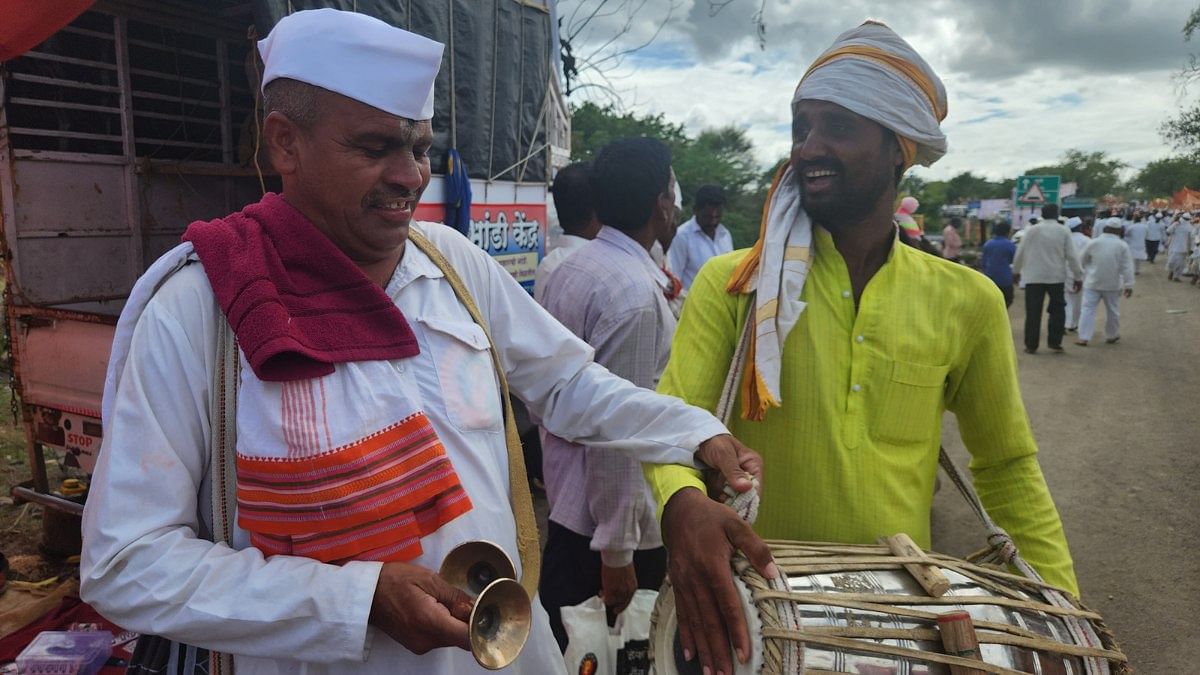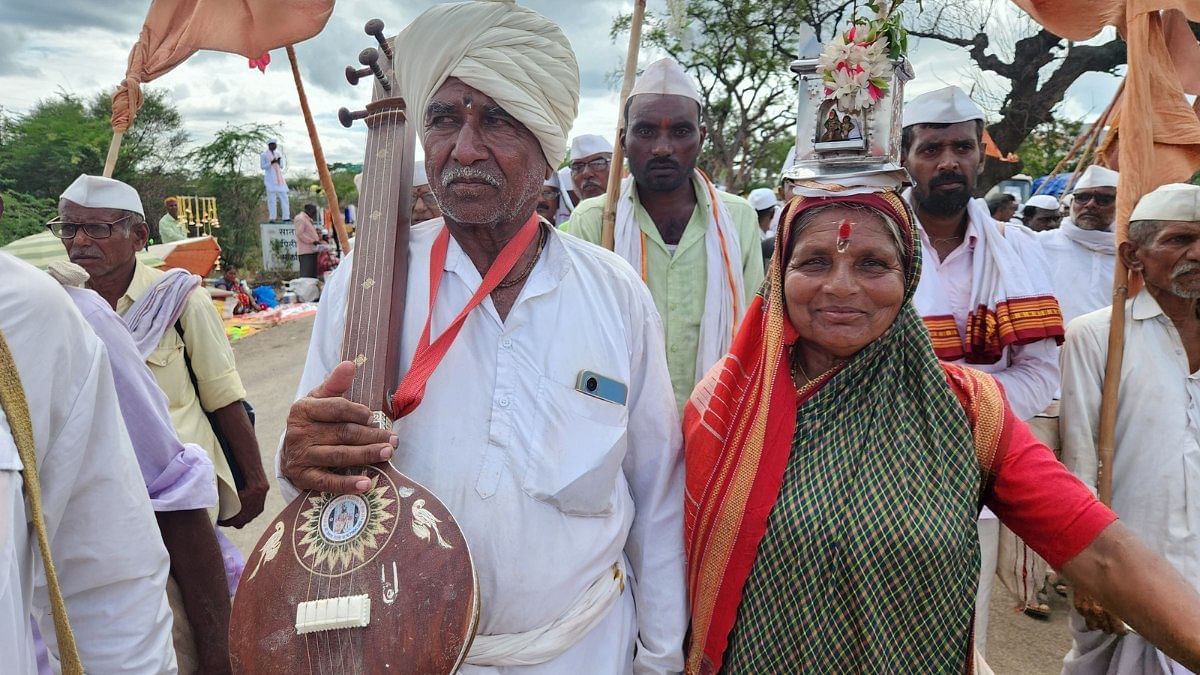[ad_1]
Pandharpur: A Mumbai-based engineer, a farmer, a supplier of LPG cylinders, a student and a homemaker were among the Warkaris who walked 250 kms to Pandharpur in Maharashtra’s Solapur district amid chants of “Mauli Mauli (Lord)“, reverberating sounds of abhangas (devotional songs) and those of the traditional instruments taal and mridangam.
This was the setting of the ‘Wari’ — the annual pilgrimage undertaken by pilgrims who are also called Warkaris. The pilgrimage, which began from Alandi and Dehu in Pune early June and culminated at the Vitthal-Rukmini temple in Pandharpur on Ashadhi Ekadashi (Thursday), was carried out this year under the keen glare of all political parties, including Telangana’s Bharat Rashtra Samithi (BRS), who made efforts to tap it for political mileage.
The buzz surrounding BRS chief and Telangana CM K. Chandrashekar Rao’s presence during the ‘Wari’ made national headlines, besides attempts by the Eknath Shinde-led Maharashtra government to flex its muscles. An incident of overcrowding at Alandi in the Pune district from where the ‘Wari’ begins and videos of police trying to restrain Warkaris, meanwhile, gave the Opposition in the state an opportunity to score some brownie points.

One reason why all political stakeholders have been making attempts to woo the Warkaris is because the community represents a slice of Maharashtra itself. Its followers cut across caste, gender and class, united in their devotion to saints Dnyaneshwar, Tukaram, Namdev, Eknath, and Muktabai. The Warkaris do not subscribe to any particular caste or religion.
“There are no caste-based differences here. Tolerance and inclusivity are the essence of the ‘Wari’. Just like how the sunlight is for everyone and raindrops don’t differentiate. Here, there is no man or woman or any upper caste or lower caste. We are all just Warkaris,” said Babasaheb Chorghe, dressed in white and wearing a cap with ‘Mauli’ printed on it.
Claiming to be apolitical and ‘caste-less’, Warkaris say they trace their roots to the Bhakti movement which endorses the desire for a direct relationship with God while rejecting the rules and rituals imposed by society.
Chorghe, who hails from Karad in Satara district and works as delivery partner for a medical distributor in Mumbai, said he embarked on his first ‘Wari’ at the tender age of eight. “This is my 47th year,” he told ThePrint.
In popular culture, the annual pilgrimage of ‘Wari’ is believed to have begun with saint Dynaneshwar’s pilgrimage to Pandharpur from Alandi in the 13th century to worship Lord Vitthal and his consort, Rukmini. Like Chorghe, about 15 lakh devotees from across Maharashtra joined the pilgrimage this year, according to the local police, to “immerse themselves in devotion” for 21 days leading up to Ashadhi Ekadashi.
This time around, the temple town of Pandharpur was awash with banners, posters, hoardings put up by political parties everywhere along the pilgrimage path. These banners, showing leaders of political parties dressed as pilgrims, welcomed the Warkaris.
According to political analyst Prakash Bal, the involvement of politicians in the ‘Wari’ can be traced back to the past decade.
“‘Wari’ or Warkaris had nothing to do with any religion. But Hindutva leaders marking their presence in the ‘Wari’ seems like an attempt to spread Hindutva among them. For decades, the state government provided facilities for the Warkaris and the chief minister did the puja but the involvement of government was restricted to just that,” he said.
Bal added that for politicians, Warkaris only amount to a vote bank, which is why one could spot banners and posters of political parties as far as the eye could see along its route, “which was not the scenario few years ago”.
However, if Chorghe is to be believed, “These politicians are only doing their marketing. It is just business for them. And Warkaris are not into business.”
‘Legs don’t hurt as devotion is paramount’
The ‘Wari’ starts from the temple of Lord Vitthal in Alandi and Dehu, towns near Pune, in the first weeks of the Ashadh month (the fourth month of the Hindu calendar).
Warkaris are a mixed demographic and include children accompanied by parents, besides senior citizens, all dressed in simple clothes — a basic cotton kurta, or simple sarees and minimal jewellery — nothing that gives away their social or financial status.
When they begin the ‘Wari’, they say, they cast aside all their worldly troubles. The only task ahead of them is getting to the ghats — the journey undertaken on foot in the scorching heat and at times, amid downpour.

“For three days, the sun was scorching our skin. I thought I wouldn’t be able to walk anymore, but it started raining on the fourth day and I continued with renewed vigour. My legs don’t hurt as devotion is paramount. You cannot have such an experience elsewhere,” said Narendra Kirtikar, a Mumbai-based Warkari who started his pilgrimage from Alandi.
The most important part of a ‘Wari’ are the palkhis, or palanquin of saints organised by temple trusts which many dindis (processions) follow. Media reports said there were 43 palkhis this year. But the oldest and most revered are the palkhis of Dnyaneshwar and Tukaram that contain their padukas (representation of their feet).
This past Thursday, Ektari Veena in one hand and black tika on their foreheads, thousands of devotees, mostly from rural Maharashtra, entered the temple town of Pandharpur, chanting the Lord’s name — “Mauli Mauli, Dnyaneshwara, Tukaram, Namdev, Eknathdnyaneshwara, tukoba Mauli”.

Many women walked the ‘Wari’ in a traditional nine-yard saree, singing abhangas of Lord Vitthal and saints Dnyaneshwar and Tukaram, and some playing the phugdi (locking hands and going in circles). Others balanced a Tulsi Vrindavan (Tulsi plant) on their heads while keeping pace with the dindi.
“It is a symbol of Rukhmai (Rukmini) so as a mark of respect, we never put it down or even carry it in our arms,” said Rohini Jamble, who came all the way from Jalna to participate in the ‘Wari’. “We just pass it on from one head to another,” said Jamble, a farmer.
Warkaris then flooded the banks of river Chandrabhaga, where the temples of Lord Vitthal and Rukhmai are situated, for ablutions before darshan of their Lord.
Many pilgrims ThePrint spoke to had been embarking on the ‘Wari’ for two or three decades — an annual family tradition.
Sixty-one-year-old Harikishan Bhatkal from Jalna, who ‘sells LPG cylinders’, said he started walking the ‘Wari’ because of his uncle and grandfather. In his 35th year now, he was joined by his son this time around.
Vishan Baviskar, a 22-year-old Mumbai-based engineering student, was a first-timer born in a family of Warkaris. Baviskar, who also fought a bout of illness while walking the ‘Wari’ said, “I couldn’t join earlier because of my studies. When I see an old man of 70-75 years walking, I realise there is so much more to learn, I have barely done anything in life.”
‘Politics doesn’t work in our community’
Last year, in what was seen as an outreach, Prime Minister Narendra Modi had inaugurated a rock temple at Tukaram’s temple in Dehu.
This time around, the Eknath Shinde-led Maharashtra government announced an insurance plan for Warkaris, which according to media reports, covers the duration of the pilgrimage and allows pilgrims to submit claims under various heads.
CM Shinde, who visited Pandharpur on Ashadhi Ekadashi and performed the traditional puja at the temple, visited the temple town Monday to ‘inspect the preparedness’.
According to the cops near the temple, about 7,000 Maharashtra police personnel were deployed across Pandharpur to maintain law and order and ensure the safety of pilgrims.
Meanwhile, Telangana CM KCR, who has been trying to expand his party in Maharashtra visited Pandharpur Tuesday. Although he addressed a public gathering in the temple town, his request to shower flower petals on Warkaris from a helicopter was denied.
“We are just children of Mauli. Politics doesn’t work in our community…We are here out of devotion,” 30-year-old Sitaram Bhendekar, a farmer and musician who plays the dhol in dindi, told ThePrint.
(Edited by Smriti Sinha)
Also read: Aurangabad city may have been renamed, but Maharashtra politics is not quite done with Aurangzeb










